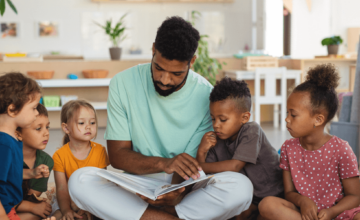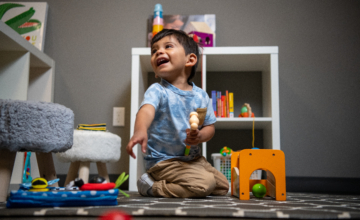It’s so important for parents to help their child learn how to cope with their feelings. Learn how parents are their child’s guide in sharing the joys and coping with the challenges, starting on day one.
 It wasn’t that long ago that the conventional wisdom was that babies were pretty much blobs who didn’t think or feel much before they could speak in words around age 2. The idea that a 6-month-old could feel fear or anger, no less sadness and grief, was preposterous. But thanks to an explosion in research on infancy in the last 30 years, we now know that babies and toddlers are deeply feeling beings. Starting in the earliest months of life, well before they can use words to express themselves, babies have the capacity to experience peaks of joy, excitement, and elation. They also feel fear, grief, sadness, hopelessness, and anger—emotions that many adults understandably still find it hard to believe, or accept, that very young children can experience. Research has also shown that children’s ability to effectively manage their full range of emotions, also known as self-regulation—is one of the most important factors for success in school, work, and relationships into the long-term.
It wasn’t that long ago that the conventional wisdom was that babies were pretty much blobs who didn’t think or feel much before they could speak in words around age 2. The idea that a 6-month-old could feel fear or anger, no less sadness and grief, was preposterous. But thanks to an explosion in research on infancy in the last 30 years, we now know that babies and toddlers are deeply feeling beings. Starting in the earliest months of life, well before they can use words to express themselves, babies have the capacity to experience peaks of joy, excitement, and elation. They also feel fear, grief, sadness, hopelessness, and anger—emotions that many adults understandably still find it hard to believe, or accept, that very young children can experience. Research has also shown that children’s ability to effectively manage their full range of emotions, also known as self-regulation—is one of the most important factors for success in school, work, and relationships into the long-term.
So a critical first step in helping your child learn to cope with her feelings is not to fear the feelings, but embrace them—all of them. Feelings aren’t right or wrong, they just are. Sadness and joy, anger and love, can co-exist and are all part of the collection of emotions children experience. When you help your child understand her feelings, she is better equipped to manage them effectively.
One major obstacle in doing this that I see quite often in my work with parents is that they are operating under the false assumption that having a happy child means he needs to be happy all the time (something I still have to keep reminding myself despite the fact that my children are in their 20s!) Muscling through difficult experiences, mastering struggles, coping with sadness and grief, builds strength and resilience, and is ultimately what brings children a sense of contentedness and well-being.
What can parents do?
Starting in the earliest months, tune in to babies’ cues—their sounds, facial expressions, and gestures—and respond sensitively, which lets babies know their feelings are recognized and important. This might mean stopping a tickling game with a 4-month-old when she arches her back and looks away, signaling she needs a break. Or taking a 9-month-old to the window to wave good-bye to Mom when she is sad to see her leave for work.

Label and help toddlers cope with feelings.
Emotions like anger, sadness, frustration, and disappointment can be overwhelming for young children. Naming these feelings is the first step in helping children learn to identify them, and it communicates to children that these feelings are normal. This might mean acknowledging an 18-month-old’s anger at having to leave the playground as you help him into the car seat; validating a 2-year-old’s frustration at his block tower falling again and again; or empathizing with a 3-year-old’s sadness that his grandparents are leaving after a long visit.
Don’t fear the feelings.
Feelings are not the problem. It’s what we do—or don’t do—with them that can be problematic. So listen openly and calmly when your child shares difficult feelings. When you ask about and acknowledge feelings, you are sending the important message that feelings are valued and important. Recognizing and naming feelings is the first step toward learning to manage them in healthy, acceptable ways over time.
Avoid minimizing or talking children out of their feelings.
This is a natural reaction—we just want to make the bad feelings go away. Don’t be sad. You’ll see Joey another day. But feelings don’t go away, they need to be expressed one way or another. Acknowledging a child’s strong feelings opens the door to helping her learn how to cope with them. You are sad Joey has to leave. You love playing with him. Let’s go to the window to wave good-bye and make a plan to see him again soon. When feelings are minimized or ignored, they often get expressed through aggressive words and actions, or by turning them inward, which can ultimately make children anxious or depressed.
Teach tools for coping.
If your 18-month-old is angry that iPad time is over, guide her to stamp her feet as hard as she can or to draw how angry she is with a red crayon. Help a 2-year-old who is frustrated at not being able to get the ball into the basket brainstorm other ways to solve the problem. Take a 3-year-old who is fearful about starting a new school to visit the classroom beforehand—meet the teachers and play on the playground—so that the unfamiliar can become familiar.
The fact is that our children’s emotional reactions trigger our own emotional reactions, which can lead to a knee-jerk need to rescue or “fix” whatever is causing our child distress. But it’s important that we manage our own feelings and avoid this temptation, as it creates a missed opportunity to help children learn strong coping skills. Instead, see these experiences as teachable moments to help your child learn to name and manage the emotions—positive and negative—that add depth and color to our lives. Show your child that a full, rich life means experiencing both the ups and the downs. Feelings are not “good” or “bad”—they just are. You are your child’s guide in in sharing the joys and coping with the challenges. And it starts on day one.




